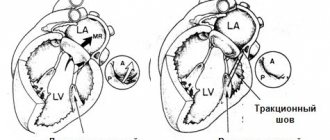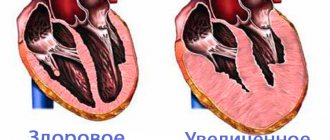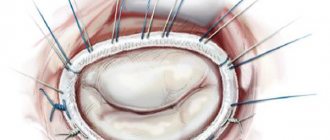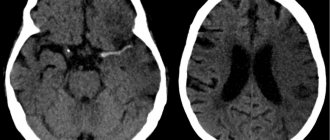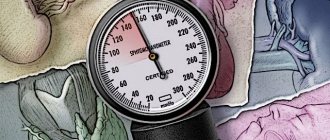Causes
There are two types :
- congenital;
- acquired.
The development of the disease is influenced by a certain number of aspects, among which are:
- Infectious (viral, bacterial, fungal, etc.).
- Helminthic infestations (echinococcosis, trichinosis).
- Factors of a toxic or chemical nature (insect bites, snake bites, exposure to chemicals on the body, drugs or alcohol).
- Aspects of physical health (overwork, overheating).
- The influence of drugs and other means (vaccination, antibiotics).
- Allergic reactions.
From the above reasons, it becomes clear that the disease can mainly manifest itself in children who have had viral or bacterial infections ; in addition, such children are susceptible to allergic reactions. Therefore, it is a good idea for parents to limit the consumption of foods to which the baby is allergic. Otherwise, you can only aggravate the situation and only cause harm.
Read also: Ultrasound of the child’s heart (echocardiography)
Types of myocarditis depending on the causes
The classification of the disease according to the ICD is based on the cause-and-effect factor that causes myocarditis. Depending on the provocateurs, the disease takes the following forms:
- Infectious myocarditis
Infectious diseases of various origins, in severe manifestations, cause complications on the myocardium - inflammation develops. The cause may be all kinds of herpes, influenza, and hepatitis viruses. Bacterial diseases. Fungal pathologies of Candida and Aspergillus. Parasitic organisms. Diphtheria bacillus, chlamydia, streptococcus.
- Rheumatic myocarditis
It is a derivative of infectious myocarditis. Develops against the background of a depressed immune system. The main reason is hemolytic streptococcus, which causes pathologies on the mucous membranes.
- Allergic myocarditis
The disease develops against the background of an allergic reaction. In this case, the factors can be very different. Burns that provoke the release of large amounts of toxic substances into the blood. Organ transplantation, transplantation leading to implant rejection and myocardial damage. Allergy to drugs, as a result of which the drugs cause inflammation of the heart muscle.
- Toxic myocarditis
Alcohol poisoning, kidney failure, which results in increased uric acid levels, and heavy metal vapors can cause inflammatory processes in the myocardium.
- Symptomatic myocarditis
The consequence of chronic diseases can be myocarditis. As a rule, these are autoimmune diseases - lupus erythematosus, rheumatoid arthritis, scleroderma, which have an extremely negative effect on all internal organs, including the heart.
- Idiopathic myocarditis
A disease with unknown etiology. It is characterized by partial damage to the myocardium and a severe form of the course. Most often it becomes the cause of death. This is due to the current impossibility of establishing the causes of development.
Based on the classification of the disease, most existing infections can cause an inflammatory process in the heart muscle. Therefore, even a seemingly banal cold can give impetus to the inflammatory process in the myocardium. A preventive examination after a viral illness is the best way to prevent myocarditis.
Important! A timely detected and fully treated infection minimizes the risk of complications affecting the heart muscle.
Myocarditis - symptoms
The distinctive characteristics and features of the manifestation of inflammation alone are not known; the disease can manifest itself against the background of others, so it is often not possible to determine it in a timely manner. But there are characteristic symptoms of myocarditis that doctors highlight:
- severe or aching pain in the heart area;
- irregular rhythm or pulse, it seems as if the heart is “turning over”;
- shortness of breath that occurs regardless of the intensity of physical activity;
- cough;
- blue nose, legs, arms;
- circulatory disorders;
- swelling in the legs;
- rapid patient fatigue;
- Increased body temperature is less common;
- general weakness.
Particular attention should be paid to newborn children ; if you notice signs of illness in them, then immediately seek the advice of your attending physician , who will help identify the illness that has appeared in time.
DIAGNOSIS AND TREATMENT of myocarditis
Myocarditis is a clinical syndrome characterized by many possible causes and manifestations. It is believed that viral infection is the most common cause of myocarditis, but similar changes can be caused by other infectious and non-infectious factors, the impact of which leads to inflammatory infiltration between cardiomyocytes.
Not only the causative factors of this pathological condition, but also its manifestations are very diverse. The diagnosis is clear in the presence of clear and characteristic signs of acute cardiac dysfunction that has arisen in connection with a viral disease, but with an erased clinical picture, diagnosing myocarditis is a very difficult task.
Definition. Myocarditis is a pathological condition in which an active inflammatory process occurs in the myocardium with necrosis and degenerative changes in cardiomyocytes; the pathomorphological picture differs from the changes observed during infarction. Cell death and fibrosis are observed. Inflammatory infiltration can be represented by any type of immune cells, and the histological nature of the inflammatory reaction often indicates the etiological factor.
Morbidity. It is difficult to give exact figures regarding myocarditis, since this pathological condition is very heterogeneous: in some cases it occurs hidden and therefore does not come to the attention of doctors; its chronic form can lead to dilated cardiomyopathy with manifestation many years after the onset of the disease.
Myocarditis is found in 1-4% of routine autopsies. In Europe and North America, viral infections are considered the most common cause of myocarditis. Cardiac pathology, according to some estimates, develops in 5% of all cases of viral diseases; however, clinically significant cardiac damage, according to large studies, is observed in 0.5-5.0% of cases.
The incidence is influenced by extreme factors, including age, as well as pregnancy and time of year. The incidence of myocarditis is high in infants, with a second peak in adolescence.
Etiology. The inflammatory response in the myocardium can arise from a number of different influences that damage cardiomyocytes (see table). Viral infections are considered the most common cause of myocarditis.
The mechanisms of damage to cardiomyocytes during viral infections are being actively studied: it is currently believed that viruses change the antigens expressed by cardiomyocytes, therefore, in addition to the direct replication of the pathogen, these cells are damaged by a constantly ongoing cellular immune reaction.
If this is so, then the immune response in a given patient determines the clinical manifestations of the infection.
Coxsackie viruses A and B, enteroviruses and influenza viruses are the most common etiological factors of myocarditis. Approximately 25-40% of patients infected with HIV (human immunodeficiency virus) show signs of cardiac dysfunction, which manifests itself clinically in 10% of cases.
Recently, there has been increasing recognition of the fact that cardiac pathology can also develop as a long-term complication of radiation therapy, with damage to the myocardium, valves or arteries - sometimes many years after irradiation. More advanced radiation therapy techniques are designed to protect against such complications.
Pathomorphology. Direct exposure to ionizing radiation, exposure to a toxin (such as in diphtheria), or an autoimmune reaction (such as in Mycoplasma pneumoniae infection) can damage cardiomyocytes and cause heart failure and arrhythmias, with the clinical picture depending on the extent of the damage.
Inflammation gives the myocardium a pale tint with rare small hemorrhages. Microscopy reveals a disturbance in the structure of muscle fibers due to interstitial edema and isolated foci of necrosis. The inflammatory infiltrate is usually represented by lymphocytes.
Depending on the etiological factor, more specific histological features may be found, such as non-caseating granuloma in sarcoidosis (see Fig. 1). Subsequently, complete resolution of the process often occurs without residual fibrosis, but in some cases focal healing with interstitial fibrosis is observed.
| Figure 1. Myocardial biopsy specimen for sarcoidosis (hematoxylin and eosin staining): inflammatory lymphocytic infiltration and non-caseating granuloma are visible |
Clinical signs. Clinical manifestations are very diverse and depend on the degree of cardiac dysfunction and the nature of the etiological factor.
Viral myocarditis may be preceded by a prodromal phase with flu-like symptoms, fever, muscle and joint pain, and rash. The time between the appearance of these signs and the onset of symptoms of cardiac pathology can range from several weeks to several years. Coxsackievirus appears to be the most cardiotoxic, especially in children.
Myocardial damage first manifests itself in the form of fatigue, shortness of breath, chest pain and palpitations, sometimes in the form of fainting. These symptoms are explained by insufficiency of systole and damage to the conduction system.
Chest pain may be associated with body position and movement, suggesting the possibility of pericarditis. In severe cases, acute left or right ventricular failure and cardiogenic shock occur. Sudden death may occur due to abnormal heart rhythms.
Physical examination reveals signs of heart failure: tachycardia (in classic cases, it is more pronounced than could be explained by fever), gallop rhythm, and in more severe cases, pulmonary edema or peripheral edema. The heart size is usually normal, and a murmur of mitral regurgitation may be heard. Sometimes atrial fibrillation develops. In some cases, a pericardial friction rub may be heard.
Diagnostics. There are no specific clinical signs on the basis of which this diagnosis could be made. The combination of an acute infectious disease and symptoms of myocardial pathology gives reason to suspect myocarditis.
Myocardial pathology can be judged on the basis of ECG data (see Fig. 2), chest x-ray, echocardiography and determination of the level of cardiac enzymes. Pathological signs on the ECG are often observed in the form of nonspecific changes in the ST segment and T wave.
An X-ray of the chest organs reveals signs of pulmonary edema, and the heart may be enlarged. Echocardiography often reveals left ventricular dysfunction, and this change may be regional rather than diffuse. Nonspecific indicators of inflammation: leukocytosis, erythrocyte sedimentation rate, and C-reactive protein also help make the diagnosis.
The presence of an acute viral infection is confirmed by analyzing swabs from the throat, stool, and also on the basis of serological tests (which can reveal a fourfold increase in antibody titer). Sometimes it is possible to isolate the pathogen from fluid taken from the pericardial cavity.
Among the more complex research methods, gallium-67 scanning can be noted, which can detect an active inflammatory process.
Some tertiary centers advocate myocardial biopsy.
Treatment of myocarditis is carried out with the aim of:
- maintaining the pumping function of the heart and reducing the risk of progression of heart failure,
- fight against arrhythmia,
- identifying and eliminating sources of toxicity.
Ideally, all patients with suspected myocardial damage should be admitted to hospital and monitored to see how effective the treatment is.
General supportive measures include bed rest and restriction of physical activity. Animal experiments have clearly shown that exercise during acute myocarditis is harmful; During the recovery period, patients should be advised to limit sports activities. This is important given that many patients suffering from this disease are young.
In the acute phase of myocarditis, the condition of patients must be carefully monitored. For congestive heart failure, conventional treatment with diuretics and angiotensin-converting enzyme inhibitors is effective, as well as anticoagulant therapy when there are signs of peripheral or pulmonary embolism, severe ventricular failure, or atrial fibrillation.
In some cases, a clinical picture of cardiogenic shock and low ventricular output is observed, and adequate intensive care is necessary.
Arrhythmia may occur, requiring specific therapy. Occasionally, there is a need for temporary or permanent implantation of artificial pacemakers. It is generally accepted that the risk of sudden cardiac death is increased following myocarditis, especially in younger patients.
Specific therapy directed at the causative factor is limited. Since in most cases myocarditis develops against the background of viral infections and is based on immunological reactions, some studies have examined the role of antiviral and immunosuppressive therapy. Many of these studies were poorly controlled and their results were inconclusive. Currently, there are no clear data on the basis of which immunomodulatory therapy can be recommended.
It is best not to prescribe non-steroidal anti-inflammatory drugs, as some animal studies have shown that their use increases heart damage.
Most patients recover completely without evidence of residual cardiac dysfunction. Echocardiography allows accurate and noninvasive assessment of cardiac function, and, at least until cardiac function returns to normal, all patients should receive angiotensin-converting enzyme inhibitors.
With residual myocardial dysfunction, continuous treatment and specialist supervision is required, since in a small percentage of cases the disease recurs. Often the causative factor cannot be identified, but when it is known, it must be adequately addressed.
Rajesh K. Kharbanda , Fellow, British Heart Research Foundation Howerd Swanton , MD, Fellow, Middlesex Hospital
Myocarditis - how is diagnosis done?
At the first signs, immediately contact a clinic where competent doctors work. They will conduct a targeted examination and give directions for further, detailed examination. But, there are stages of diagnostics:
- External examination of the baby . An experienced cardiologist immediately diagnoses that the heart muscle is inflamed. A blue tint to the face, swollen legs, swollen veins, hard breathing, all this makes it clear to the specialist that it is necessary to check the functioning of the heart as a whole.
- Percussion . At this moment, the doctor “tapping” and accurately determines the boundaries of the expansion of the heart muscle.
- Using a phonendoscope, the doctor listens to the frequency and rhythm of the heartbeat;
But, unfortunately, not every pediatrician is able to make a correct and clear diagnosis, so most likely you will be referred for a thorough examination using special devices that will give a complete picture of the child’s condition. Myocarditis and its diagnosis require increased attention from parents ; some notice manifestations quite late, which significantly aggravates the situation.
Myocarditis - basic definition
Inflammation of the heart muscle that is not associated with impaired blood circulation in the coronary arteries is called myocarditis. The disease affects the middle layer of muscle tissue - the myocardium. The causative agents are specific infections and viral pathologies. In some cases, inflammation can be triggered by allergic, autoimmune diseases and acute intoxication. According to the World Health Organization, myocarditis is diagnosed in 10% of cases of all heart diseases.
The main danger of the pathology is the absence of an age threshold. Myocarditis can develop in both children and the elderly. Although the prognosis for most cases is positive, the disease is highly unpredictable. Without timely diagnosis and treatment, a sudden disturbance in heart rhythm may occur - arrhythmia, which causes extremely serious consequences, including death.
Treatment
The main attention in the conservative treatment of myocarditis is paid to etiotropic therapy - elimination of causes and complications. In the first stages, hospitalization occurs, a strict diet is prescribed, bad habits are eliminated, and inflammation is relieved.
The standard scheme of therapeutic measures is as follows:
- Strict bed rest in a hospital for at least four weeks;
- Limiting physical activity;
- Supportive complex therapy;
- Taking a wide group of anti-inflammatory drugs – NSAIDs;
- Antibiotic treatment for specific viral pathologies;
- Prescription of hormonal drugs - glucocorticosteroids (GCS). It is used in severe cases to suppress the hormone cortisone, which is responsible for the development of inflammatory processes;
- Immunomodulation. Maintaining and restoring the body’s protective function;
- Correction of metabolic processes. To enrich the heart muscle with oxygen and nutrients;
- Preventive vitamin course.
Compliance with basic treatment standards is the key to successful treatment. Therefore, self-medication of heart pain is strictly contraindicated. This can lead to irreparable complications, the mildest of which will be myocardial infarction. The patient is only required to be attentive to his own health - to listen to the first alarm bells of the body and undergo a timely examination. Only a cardiologist can make the correct diagnosis and prescribe treatment after a complete history collection.
Complications
The consequences of advanced myocarditis are negative processes in the heart muscle. Depending on the course and form of the disease, irreversible changes may appear in the myocardium, which lead to disruption of the normal functionality of the heart muscle - blood pumping. In extreme cases, the lesions are so severe that they lead to cardiac arrest and sudden death.
Long-term myocarditis leads to abnormal enlargement of the heart muscle. The process is irreversible, so in such cases the patient is advised to undergo long-term therapy and a complete overhaul of their lifestyle.
The most severe consequences are considered to be giant cell myocarditis. Most patients with this diagnosis require heart transplantation. Otherwise, cardiologists give an unfavorable prognosis for life. According to WHO, approximately 90% of patients die within 4-5 years if a heart transplant is not performed.
The inflammatory process in the myocardium contributes to scarring of muscle tissue, which in turn completely disrupts the heart rhythm and blood supply. This leads to the development of heart failure and, as a rule, ends with ischemic heart disease.
But in most cases, normal heart function is restored, although it requires long-term preventive treatment and lifelong monitoring by a cardiologist.
